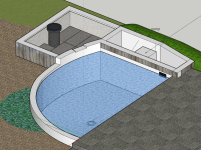- Joined
- Aug 12, 2022
- Messages
- 128
- Reaction score
- 42
- Country

After a couple of years of thinking we hope to start work on landscaping our garden, we only been here for 20+ years, as part of the landscaping I will be putting a bigger better pond. The current pond is a small raised bed pond, this one will around 10 bigger
It's a bit of hybrid pond using a bottom drain and a bog filter. Over the next few days I want to finalise the design and may have quite few questions.


It's approximate dimensions are 5300 x 3700 and 1250 mm deep, with a volume around 21000 ltrs or around 5500 US gallons
It's walls will be 100mm concrete blocks laid on the side, with a box welded liner, around 1/4 of it will be above ground.
Because I'm using a bottom drain I was advised to use a settlement before the water was pumped to the bog filter, as it was difficult to fit an adequate size tank in, I've decided to go for drum filter to keep maintenance down. (the dirty water from self cleaning will be pumped into near by planting area.
So i will have a skimmer and bottom drain feeding into a drum filter and then the water will be pumped into the bog filter. The bog filter will be loosely based on the aquascape type wetland filter, but using standard building components, soakaway crates, drilled twin wall pipe as caterpillars, inspection chamber for snorkel etc.
So question:
1. Because we wanted a crisp pond with vertical sides, we are going for concrete blocks, with a box welded liner with underlay. Bearing in mind the shape of the pond are there any cost effective alternate methods instead of using the welded box liner?
I will really appreciate any responses.
Thanks
Gary
It's a bit of hybrid pond using a bottom drain and a bog filter. Over the next few days I want to finalise the design and may have quite few questions.
It's approximate dimensions are 5300 x 3700 and 1250 mm deep, with a volume around 21000 ltrs or around 5500 US gallons
It's walls will be 100mm concrete blocks laid on the side, with a box welded liner, around 1/4 of it will be above ground.
Because I'm using a bottom drain I was advised to use a settlement before the water was pumped to the bog filter, as it was difficult to fit an adequate size tank in, I've decided to go for drum filter to keep maintenance down. (the dirty water from self cleaning will be pumped into near by planting area.
So i will have a skimmer and bottom drain feeding into a drum filter and then the water will be pumped into the bog filter. The bog filter will be loosely based on the aquascape type wetland filter, but using standard building components, soakaway crates, drilled twin wall pipe as caterpillars, inspection chamber for snorkel etc.
So question:
1. Because we wanted a crisp pond with vertical sides, we are going for concrete blocks, with a box welded liner with underlay. Bearing in mind the shape of the pond are there any cost effective alternate methods instead of using the welded box liner?
I will really appreciate any responses.
Thanks
Gary


